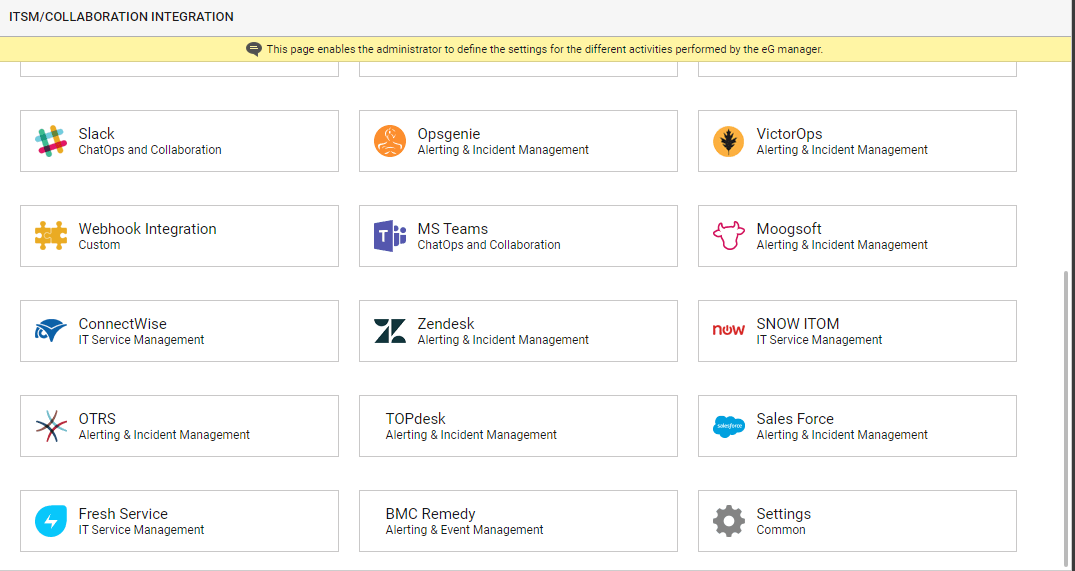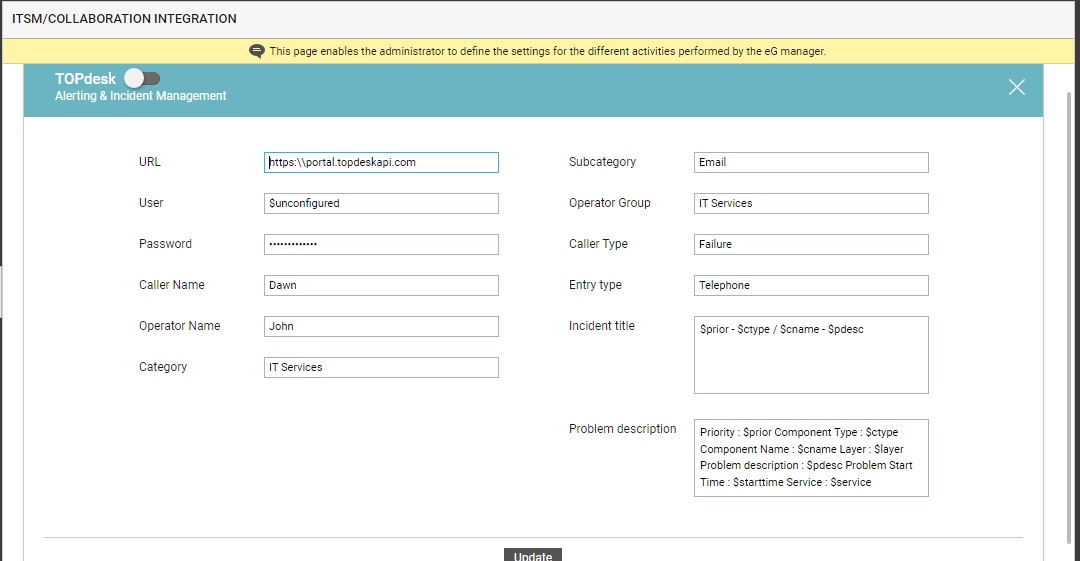Integration with TOPdesk
TOPdesk's Incident Management system lets you easily register all incoming tickets and track them to closure.
eG Enterprise integrates with TOPdesk's Incident Management system. eG alerts are automatically transmitted to TOPdesk via REST API, thereby enabling the automatic generation, modification, or closure of trouble tickets (as the case may be) in TOPdesk.
To integrate eG Enterprise with TOPdesk, do the following:
- Login to the eG administrative interface.
-
Select the Manager option from the Settings tile.
-
Figure 55 will then appear. From the manager settings tree in the left panel of Figure 55, select the ITSM/Collaboration Integration node. The third-party ITSM/Collaboration tools that eG Enterprise can integrate with will be listed in the right panel.

-
Now, click on the TOPdeskoption in the right panel (see Figure 55). A TOPdesk section will now appear in the right panel (see Figure 56).

- To enable integration with TOPdesk, first slide the TOPdesk slider in Figure 56 to the right.
-
Then, specify the following in Figure 56:
- URL: eG Enterprise integrates with TOPdesk using REST API. The eG manager POSTs eG alerts to the endpoint URL of the API as JSON payloads containing alert information. To enable the eG manager to connect to the API, you need to specify the endpoint URL here.
-
User name and Password: To enable the eG manager to connect to TOPdesk, you need to create an application password in TOPdesk. Specify this application password against Password. Against User name, specify the name of the person you logged into TOPdesk as to create the application password.
- Caller Name and Caller Type: Every trouble ticket that is registered with TOPdesk will include a caller name - i.e.,the name of the person who reported the problem. So, specify the caller name for all alerts that eG generated and sent into TOPdesk. Also, specify the caller type.
- Operator Name and Operator Group: Indicate the name of the operator who will be attending to all eG alerts, and the broad operator group to which that operator belongs.
- Category and Subcategory: Specify to which broad category and specific subcategory of alerts. the eG alerts belong.
- Entry type: This typically indicates the model via which the problem was communicated to TOPDesk - eg., Trelephone. Pick such a mode for all eG alerts, and specify it here.
-
Title: Specify the format in which the trouble ticket titles need to be displayed in TOPdesk for eG alerts. The default format is:
$prior - $ctype / $cname - $pdesc
The ‘dollared’ ($) text in the format above is a key, the value of which varies at run time, depending upon the information contained in the eG alarms. For example, in the default format above, $prior is a key that represents the problem priority, and changes according to the severity of the eG alert that has been sent to TOPdesk. You are advised against changing any of the key names.
The other keys that are part of the default format are discussed in the table below:
$ctype
Will display the name of the problematic component type
$cname
Will display the name of the problem component
$pdesc
Will display a brief problem description
-
Problem Description: Specify how problems are described in trouble tickets created in TOPdesk against alerts raised by eG Enterprise. The default problem description is as follows:
Priority : $prior Component Type : $ctype Component Name : $cname Layer : $layer Problem description : $pdesc Problem Start Time : $starttime Service : $service
The ‘dollared’ ($) text in the format above is a key, the value of which varies at run time, depending upon the information contained in the eG alarms. For example, in the default format above, $prior is a key that represents the priority/severity of an eG alert, and changes according to the actual priority of the eG alerts sent to TOPDesk. You are advised against changing any of the key names.
The other keys that are part of the default format are discussed in the table below:
$cname
Will display the name of the problem component
$ctype
Will display the problem component type
$pdesc
Will display a brief problem description
$layer
Will display the problematic layer
$starttime
Will display the start time of the problem
$service
Will display the service ID.
- Finally, click the Update button in .
